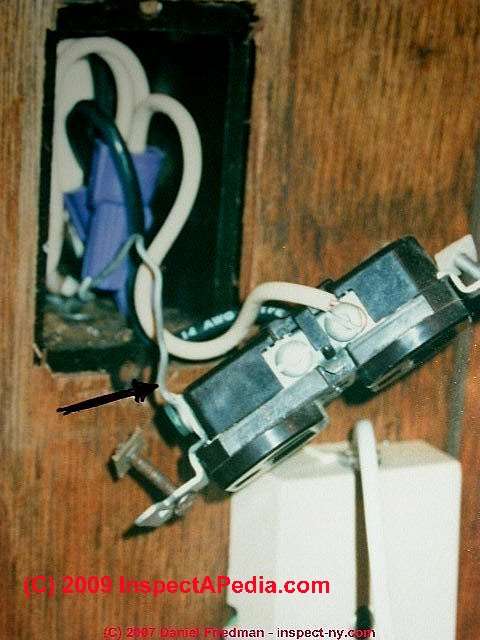 Is YOUR Aluminum Electrical Wiring Safe?
Is YOUR Aluminum Electrical Wiring Safe?
How do we assess the safety of a building with aluminum wiring?
- POST a QUESTION or COMMENT about aluminum electrical wiring in buildings: safety, proper repairs, history, recommendations.
Evaluation of the safety of aluminum electrical wiring:
What are the hazards of aluminum electrical wiring? How can the safety of an aluminum-wired building be assessed?
Is un-repaired aluminum electrical wiring in a home ever "safe"? In response to inquiry by owners or buyers of homes served by aluminum electrical wiring, we receive occasional reports that some building inspectors, electricians, building code officials, industry representatives, express the view that "Aluminum wiring in your house not likely to be a real problem," or words to that effect.
Watch out: The condition and safety of aluminum electrical wiring and devices in specific individual homes cannot be reliably assured by someone who has not examined it! General "opinions" that an un-studied installation of aluminum electrical wiring is "safe" are thus nonsense. And the safety of an un-repaired aluminum-wired building cannot be reliably ascertained by inspection & test methods typically used by electricians or home inspectors.
InspectAPedia tolerates no conflicts of interest. We have no relationship with advertisers, products, or services discussed at this website.
- Daniel Friedman, Publisher/Editor/Author - See WHO ARE WE?
Letter Responds to Claims that Original Un-Repaired Aluminum Electrical Wiring Is Unlikely to Be a Problem
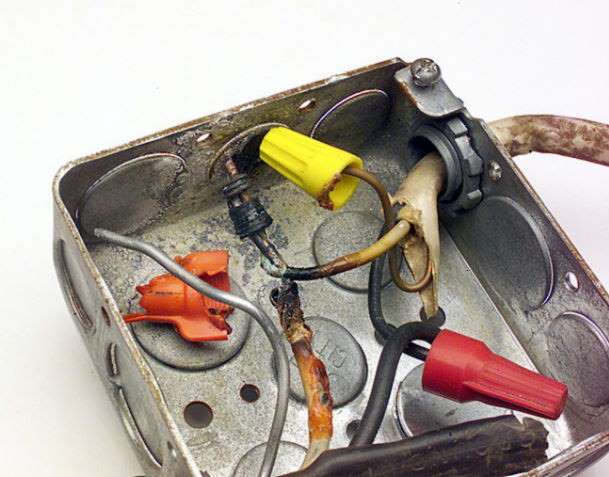 The condition of aluminum electrical wiring connections varies over an very
wide range from building to building and among individual circuits and devices
within specific buildings.
The condition of aluminum electrical wiring connections varies over an very
wide range from building to building and among individual circuits and devices
within specific buildings.
It is possible for very unsafe conditions to be present but not visible in the electrical system, so a visual inspection cannot assure that aluminum electrical wiring is safe.
Testing of aluminum wired circuits in a building is either completely unreliable (resistance testing) or dangerous, risking a building fire (overload testing), would be incomplete in any case as not all circuits and connections would be tested, and should not be performed to make a claim of overall building safety.
It is inaccurate and dangerous for anyone to make any representation about the condition of aluminum wiring in a specific property "over the telephone," and without on-site specific inspection and testing by a qualified expert who is familiar with aluminum wiring issues.
Our photograph shows an overheated and burned twist-on connector used in an attempt to "repair" aluminum wiring. [Click to enlarge any image]
In illustration of these points, just below we've quoted the text portion a 2/3/94 letter from an expert on aluminum electrical wiring..
The letter below was written to a committee charged with evaluating the safety of aluminum electrical wiring in their building(s).
The group had already received documents asserting that there were no aluminum wiring hazards and that aluminum wiring used in their building was safe and would perform as well as copper wiring.
The assertions that the un-repaired aluminum wiring in their building was "safe" and that it would perform as well as copper wire were incorrect then and they remain wrong today.
The author, Dr. J. Aronstein, can be contacted at protune@aol.com, or contact me, Daniel Friedman. Extensive information about identifying and repairing aluminum wiring safety hazards is
at ALUMINUM WIRING HAZARDS & REPAIRS.
February 3, 1994 (original addressee info) (deleted by DJF)
Subject: Aluminum wiring (deleted) : How to Make a Safety Assessment
Dear Mr. (deleted)
You requested my comments on the safety of the aluminum wiring at (deleted) and my review of the written materials provided. The question to be answered is this - are the connections to the aluminum wire at (deleted) safe? Without determining what types of connections are in the system and how they were made, nobody can answer the question.
Are the receptacles back-wired or screw-terminal wired? If screw-terminal wired, how is the wire placed under the screw (straight in or wrapped around)? Are the screws steel or brass? Are the screws plated with zinc on the neutral side?
What kind of splicing connectors exist in the system? If twist-on connectors ("wire nuts"), are they the live spring or restrained spring type?
Did the installer abrade the aluminum wire before connecting to remove the oxide?
Were the spliced wires pre-twisted together? Was a corrosion inhibitor used on all connections?
Given the answers to these questions (from direct observations), an evaluation of the relative safety of the wiring system at (deleted) can be made.
The information that they were provided with misleads as often as it informs.
What the committee was given, for the most part, was organizational positions rather than useful information.
For instance, references to aluminum cable being used in the Boeing 747 at the World Trade Center and in overhead power distribution are not relevant, since the connections systems used are quite different from those installed at (deleted).
What the NEC, the UL standards, local codes, and the wiring practices were at the time of installation and how they have changed makes for interesting discussion but sheds no light on whether or not there are serious electrical safety defects at (deleted), and, if there are, how they should be corrected.
I am concerned that a proper assessment of the state of the wiring system at (deleted) has not yet been made. The question electrical fire safety cannot yet be answered with any degree of certainty.
Yours truly,
J. Aronstein, Ph.D., P.E. JA/lsr
Can an electrician certify that an aluminum-wired building is safe?
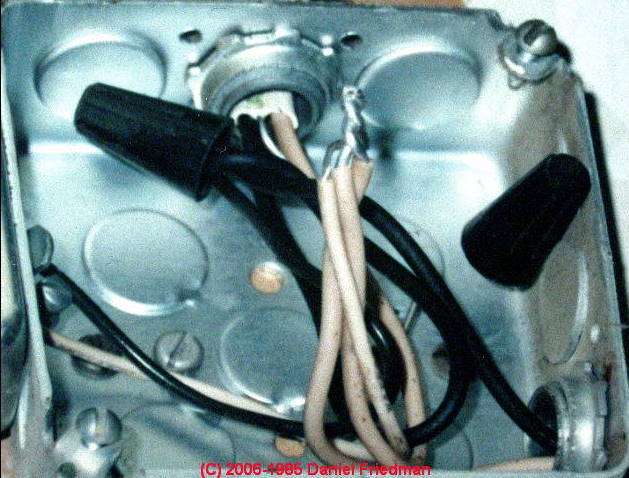 Reader question: can a licensed electrician certify that a structure with Aluminum wiring is currently safe?
Reader question: can a licensed electrician certify that a structure with Aluminum wiring is currently safe?
I was reading some of your information regarding Aluminum wiring.
A question if I may, can a licensed electrician certify that a structure with Aluminum wiring is currently safe?
Possibly via thermal imaging instruments, etc? If so, do you know if one would do so? - D.C.12/31/2013
Reply: basically, NO. Here are the types of tests and inspections that might be performed along with their shortcomings
Thank you for the interesting aluminum wiring safety question - it helps us realize where we need to work on making our text more clear or more complete.
What follows is my OPINION based on more than two decades of experience & research in topic of aluminum wiring hazards, and I am informed by others more expert than myself, but I have no approval authority and I am not an electrical engineer.
What may or can an electrician certify about aluminum wiring safety ?
I want to answer with care, which involves some semantics and picky discussion of wording, even the use of "can" and "may".
Regarding the word "may" - to my knowledge there is no authority such as local or national electrical codes that regulate or authorize an electrician to certify the safety of an electrical system.
Even a "certification" that a building is in compliance with electrical codes would be of little use where special hazards such as solid aluminum branch conductor wiring or FPE electrical panels are in place, as those hazards are not explicitly called out in most codes.
An electrician "can" do anything s/he wants by way of certification of the safety of a building's electrical system, though I would be surprised to find that any knowledgeable electrician would do something so dangerous to himself/herself or to others - as I will explain below.
And I caution that should you encounter an electrician who is willing to make such a certification, presumably for a fee, I would not only not trust the value of such a certification one iota, but I would presume that there would be absolutely no useful recourse should there later be a problem or worse a fire or injury or death in the building attributed to aluminum wiring.
So what would be the value of such a certification? None.
Levels of inspection or examination of building wiring vis-a-vis aluminum branch circuits.
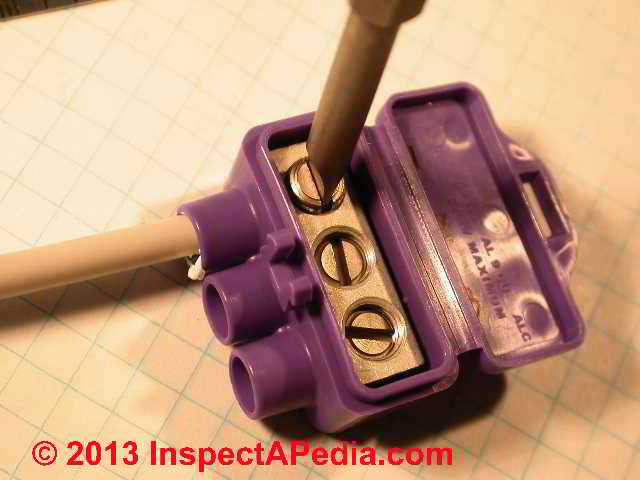
- Aluminum wiring is present:
An electrician or other trained, experienced inspector can easily report the presence of aluminum wiring in a building as there are various places where it's presence is easily detected. However it is more difficult to assert that there is NO aluminum wiring in a building without a more thorough inspection. - Aluminum wiring has been improperly repaired:
An electrician or other trained, experienced inspector can also easily report the presence of amateur or improper repairs to aluminum wiring - all it takes is finding one improper or unsafe repair such as use of a twist-on connector, or of partial "repairs" in which an approved connector was applied but not throughout all of the aluminum-wired circuits and connections. - Aluminum wiring has been properly repaired to some extent:
An electrician or other trained, experienced inspector can also easily report evidence that proper repairs appear to have been made by observing that the proper recommended connectors and pigtailing copper wire extensions have been installed, though a report that all of the wiring has been properly repaired would require considerable additional work, as there will be less easily accessible locations that need to be checked such as junction boxes in an attic, and as one would need to check torque settings if the King AlumiConn connector was used. - Tests performed on aluminum wire circuits:
an electrician could, though it would be unusual, attempt to "test" aluminum wiring circuits in place to see where resistance levels suggest that certain circuits appear to be showing evidence of overheating when in use.
Reliability & safety of tests of aluminum wire circuit resistance?
Attempts at testing aluminum electrical circuit resistance to claim that there is or is not evidence of an overheating problem when the circuit is not under load are made by some home inspectors and possibly some electricians
Watch out:This approach is fundamentally unsound - the level of electrical resistance that can actually cause overheating and a fire in aluminum-wired circuits is below the range of error or precision of all but specialized electrical test instruments.
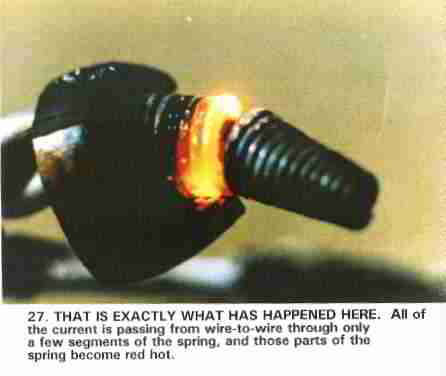 Dr. Jess Aronstein has performed such testing, but then he is a PhD forensic engineer specializing in electrical hazards, with decades of experience, and he used detailed instrumentation of all of the connections in the circuit being tested - an approach that requires a great deal of expertise and one that is considerably beyond the scope, training, certification, and equipment held by a normal licensed electrician.
Dr. Jess Aronstein has performed such testing, but then he is a PhD forensic engineer specializing in electrical hazards, with decades of experience, and he used detailed instrumentation of all of the connections in the circuit being tested - an approach that requires a great deal of expertise and one that is considerably beyond the scope, training, certification, and equipment held by a normal licensed electrician.
Aronstein's approach monitored temperature rise at each connector or device and was able to guard against a fire - not something within the scope of the home inspector or electrician tests offered using devices that simply measure resistance.
Aronstein's approach might be used in a large complex (as might other methods such as history taking and visual inspection for obvious overheating examples) to choose the order of repair of aluminum-wired circuits for the case in which the work required is so extensive that it cannot be completed in a short time.
Watch out: But the common aluminum wire "tests" performed by electricians and home inspectors are not valid and are not safe.
Simply measuring resistance in a circuit as a guess at electrical safety of an aluminum wired circuit fails to account for very significant changes that can occur in the circuit performance following a simple act such as jiggling an electrical receptacle while plugging in a vacuum cleaner, moving the location at which an electric heater is connected, or jiggling a light switch a few more times when switching it on and off.
Thus a circuit that might test as "OK" may the next day overheat.
Watch out: Worse still, attempts at testing electrical circuit operating characteristics while under load could, if not expertly performed, set a building on fire.
Accuracy & Reliability of Thermal Imaging for Finding Aluminum Wiring Hazards
I would agree that thermal imaging could detect and thus permit reporting of active locations where overheating is occurring, but while such an approach could lead to reporting of an immediate hazard, should thermal imaging fail to detect overheating that is not a reliable assurance that the circuit is safe.
Watch out: Thermal imaging can only detect overheating if overheating happens to be occurring during the time of inspection. The same variables I listed above could mean that a circuit that looks "OK" right now might overheat and cause a fire tomorrow, simply due to variations in the environment or in how a circuit is being used.
In short, absence of evidence of a hazard is never acceptable proof that a hazard is not present.
That is, as a fundamental logical principle, absence of evidence is not evidence of absence.
Balancing Repair Costs for Building Hazards - the Bathtub Curve
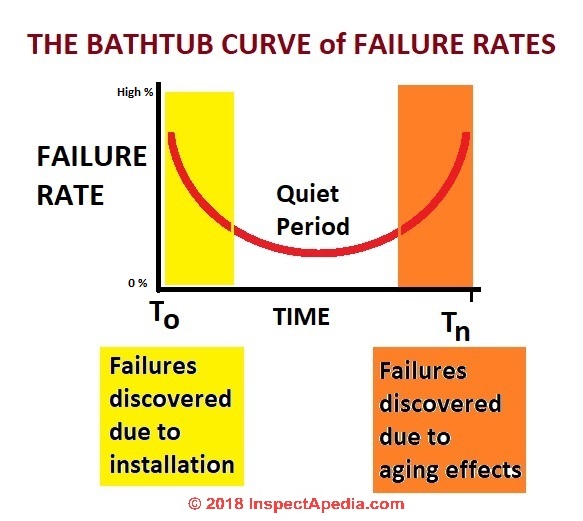 I understand the concern raised when there is a costly hazard that needs to be addressed and the discomfort that arises when one points out that overheating and failures do not occur in 100% of circuits and cases.
I understand the concern raised when there is a costly hazard that needs to be addressed and the discomfort that arises when one points out that overheating and failures do not occur in 100% of circuits and cases.
An apparently-rational approach argues: if we could we would just repair the unsafe circuits.
But this is an unsound and unsupportable approach.
Especially for the case of aluminum electrical wiring, the failure rate of these circuits is described by a "bathtub-shaped" curve. There were plenty of early failures attributed to poor installation.
Those were detected early, around T0 in our illustration. Then there may be few failures for many years - the Quiet Period in our drawing.
But as an aluminum-wired circuit ages, perhaps as it is exposed to the corrosive effects of moisture and heat, and as the is used more over time, the probability of a failure increases continuously and more rapidly.
These later-life aluminum electrical circuit wiring failures occur later in the building and wiring life in the Tn area of our illustration.
[Click to enlarge any image]
Thank you to Dr. Jess Aronstein who first pointed out this phenomenon to me. - Ed.
And as I argue above, a simple change by a new occupant, such as plugging in an electrical device where none was connected previously can completely change the risk picture.
The fancier the "testing" or "inspecting" that may be proposed for a building with aluminum electrical wiring, the more that testing costs.
Ultimately it may be smarter to spend your "test" money on having proper aluminum wiring repairs performed.
Those are described at ALUMINUM WIRING REPAIR METHODS
Conclusions about field testing of aluminum wiring
Field testing aluminum wiring for safety is impractical or impossible or unsafe
In conclusion, my OPINION is that there is no practical, safe way to test an aluminum-wired building that would let any knowledgeable, responsible party promise that the building is safe other than to assert that the aluminum wiring has been either completely replaced with copper or that absolutely all of the aluminum wired-circuits have been completely repaired - that is, that every electrical device, splice, connection, has been located and repaired using one of the two US CPSC recommended methods.
Specification of a building visual inspection program to assess the presence of or extent of aluminum wiring repair of the presence of aluminum wiring hazards
From the point of view of an insurance company, it might on further discussion, be decided that we could specify a level of inspection of a properly-repaired aluminum-wired building that would make the insurer acceptably confident that a proper repair has been made without having to literally find and re-visit every single connector - a procedure that would itself be quite costly.
Ultimately we'd be specifying a combination of historical research of the repair records (invoices, purchase records for the number of repair devices bought and presumably installed) along with specifications of the building electrical system (number of circuits and devices involving solid conductor aluminum wiring) along with a statistically sound sampling plan that chose an adequate number of devices as well as certain strategically-selected inspection points that I could specify.
It would be wise to include an inspection for the presence and operation of properly located & installed smoke detectors as well.
If you decide to pursue that approach I would be glad to offer or to find others to help offer more specific suggestions.
...
Reader Comments, Questions & Answers About The Article Above
Below you will find questions and answers previously posted on this page at its page bottom reader comment box.
Reader Q&A - also see RECOMMENDED ARTICLES & FAQs
On 2020-06-16 (mod) - Aluminum Wiring House Fire Report
AM
It would be very important and helpful to have details about this aluminum wire related house fire, including photographs, age of the house, and the city and Country where the house is located. When I know more about the fire and exactly where in the house it occurred and the extent of fire damage I might have more of an opinion about the nature of the repair that's reasonable.
In general if a house has not had a fire aluminum wiring can be safely repaired by using an approved connector at every single aluminum wire Connection in the building. It's called cover pigtailing and is described in this article series.
However after a house fire is quite possible that some or all of the wiring itself has been damaged by heat and is not safe to leave in place at all. So the position of your electricians is entirely reasonable. You are invited to use the page bottom or top contact link to send me photos and the Tails and I'll be glad to pursue this with you.
On 2020-06-15 by A M G - We had an electrical house fire. Our home was built in the 70s and has aluminum wiring.
We had an electrical house fire. Our home was built in the 70s and has aluminum wiring.
We have coding and replacement insurance coverage
. I am hearing a lot of bad things about aluminum wiring. How can I find out information on when it needs to be replaced due to fire and water damage?
A lot of contractors are not willing to work on my house unless the insurance agrees to change all of the wiring.
Is there any information on how to understand what is necessary. Thanks for your site.
On 2016-01-04 (mod)
Rhonda,
I would start with the section 8 housing authority management. If it helps you, you can take along printed copies of any of these articles on aluminum wiring safety hazards. I suggest printing out this page
https://inspectapedia.com/aluminum/Aluminum_Wiring_Summary.html
On 2016-01-04 by Rhonda - fire report - aluminum wiring ?
Who could I call to inspect for free I have been renting from an owner and section 8 an inspector from section 8 housing athority fail for a fire hazard then later passed now the electrician stated it's aluminum wiring and took the bolt to olircut breaker I believe for the owner knowing it would fail
pluss never received a copy in which now section 8 is saying it may had been given to owner t I give to me I believe that there may be fowl play
it caught fire already inside the circuit breaker a group of wires were melted together
this time I asked why it keep hapenibg that's when he exok dined so I'm wondering since I got burned a blister from a blow dryer catching fire who I could call to inspect for free thank you I am still without electricity since the 8 th.
Owner had someone else that was a third part who dies work for smud come leading me to think they were going t I fix then said she doesn't need to put copper wiring in all plug outlets only to say hint around that I may had been using more plugs on one color cut when infac t I had ni t was only using the bathroom plug which is burned
could I call someone for free to inspect if do who for sac. county or citrus heights ca. Thank you
Reader Question: where can I find an inspector to inspect the aluminum wiring in my home?
2018/05/16, Anonymous wrote by private email:
I am looking for an expert witness well versed in aluminum wiring that can inspect my home in San Jose, CA and generate an inspection report. Do you know of anyone who can do this?
Reply: on-site aluminum wiring inspections are of necessity limited in scope - or dangerous - or both
At ELECTRICIANS (for electricians in California see https://inspectapedia.com/electric/Electricians_Directory.php#CA ) we list some electricians who assert that they have experience and expertise in aluminum electrical wiring repair.
At HOME INSPECTORS-U.S (or for home inspectors just in California see https://inspectapedia.com/home_inspection/Home_Inspectors_Directory.php#CA ) are home inspectors who should be familiar with aluminum wiring.
You'll need to discuss what sort of report one of them can provide.
Watch out: Still I'm not sure what you expect to achieve with an "inspection" if you already know that your home is wired with solid conductor aluminum branch circuits.
- No visual inspection of aluminum wiring can be complete, comprehensive and affordable, though an inspection can confirm the presence of aluminum wiring, form an opinion about how extensively it is installed in the building, and it might catch some visual examples of overheating in the electrical panel or at other locations in the building.
Watch out: also that absence of evidence is not evidence of absence of unsafe electrical conditions in a building. - An inspection to find the presence of aluminum branch circuit wiring is trivial and can be done by any electrician or home inspector
- The cost of inspecting every connection approaches the cost of having the proper repair done.
- In-situ live electrical circuit testing should not be performed in your home - the risk of a house fire is too great - unless you use an expert forensic electrical engineer, and even then such tests would be anything BUT comprehensive, and the cost again approaches the repair cost.
You should read (and I'd like your comments on) ALUMINUM WIRING SAFETY ASSESSMENT - the article above on this page.
Beginning at the following page you can read about the hazards and the acceptable repair methods for aluminum wiring
ALUMINUM WIRING Information Website Aluminum Electrical Wiring Hazards and Repairs: home page, begins our series of aluminum wiring articles giving in-depth authoritative information, photos, documents including selection of proper vs. ineffective repair methods. E.g.: Ideal 65 "Twister" purple connector fails in field and lab testing with aluminum wire.
...
Continue reading at ALUMINUM WIRING IDENTIFICATION or select a topic from the closely-related articles below, or see the complete ARTICLE INDEX.
Or see these
Related Articles
- Aluminum Wiring - CPSC Publication #516 - PDF
- Aluminum Wiring - CPSC Publication #516 - Web article
- ALUMINUM WIRING HAZARDS & REPAIRS - home
- ALUMINUM WIRING REPAIR METHODS
Suggested citation for this web page
ALUMINUM WIRING SAFETY ASSESSMENT at InspectApedia.com - online encyclopedia of building & environmental inspection, testing, diagnosis, repair, & problem prevention advice.
Or see this
INDEX to RELATED ARTICLES: ARTICLE INDEX to ELECTRICAL INSPECTION & TESTING
Or use the SEARCH BOX found below to Ask a Question or Search InspectApedia
Ask a Question or Search InspectApedia
Try the search box just below, or if you prefer, post a question or comment in the Comments box below and we will respond promptly.
Search the InspectApedia website
Note: appearance of your Comment below may be delayed: if your comment contains an image, photograph, web link, or text that looks to the software as if it might be a web link, your posting will appear after it has been approved by a moderator. Apologies for the delay.
Only one image can be added per comment but you can post as many comments, and therefore images, as you like.
You will not receive a notification when a response to your question has been posted.
Please bookmark this page to make it easy for you to check back for our response.
IF above you see "Comment Form is loading comments..." then COMMENT BOX - countable.ca / bawkbox.com IS NOT WORKING.
In any case you are welcome to send an email directly to us at InspectApedia.com at editor@inspectApedia.com
We'll reply to you directly. Please help us help you by noting, in your email, the URL of the InspectApedia page where you wanted to comment.
Citations & References
In addition to any citations in the article above, a full list is available on request.
- In addition to citations & references found in this article, see the research citations given at the end of the related articles found at our suggested
CONTINUE READING or RECOMMENDED ARTICLES.
- Carson, Dunlop & Associates Ltd., 120 Carlton Street Suite 407, Toronto ON M5A 4K2. Tel: (416) 964-9415 1-800-268-7070 Email: info@carsondunlop.com. Alan Carson is a past president of ASHI, the American Society of Home Inspectors.
Thanks to Alan Carson and Bob Dunlop, for permission for InspectAPedia to use text excerpts from The HOME REFERENCE BOOK - the Encyclopedia of Homes and to use illustrations from The ILLUSTRATED HOME .
Carson Dunlop Associates provides extensive home inspection education and report writing material. In gratitude we provide links to tsome Carson Dunlop Associates products and services.

